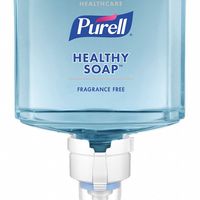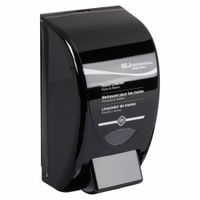Call +(254) 703 030 000 / 751 483 999 / 721 704 777
- Home
- Cleaning And Janitorial
- Hand Personal Care
- Hand Soap Cleaners Dispensers
.....Read More
Frequently Asked Questions
What is the difference between hand soap and heavy-duty hand cleaner?
Hand soap and heavy-duty hand cleaner serve the primary function of cleaning hands but differ significantly in composition, purpose, and usage.
Hand soap is designed for everyday use to remove dirt, bacteria, and oils from the skin. It typically contains mild surfactants, moisturizers, and sometimes antibacterial agents. The formulation is gentle to prevent skin irritation, making it suitable for frequent use. Hand soaps come in various forms, including liquid, foam, and bar, and often include fragrances and skin-conditioning agents to enhance the user experience.
In contrast, heavy-duty hand cleaners are formulated for more rigorous cleaning tasks. They are intended for use in industrial or mechanical environments where hands are exposed to stubborn substances like grease, oil, paint, or adhesives. These cleaners contain stronger surfactants and often include abrasive materials like pumice or microbeads to physically scrub away tough residues. Additionally, they may have solvents to dissolve heavy grime and are usually more alkaline than regular hand soaps. Despite their potency, many heavy-duty hand cleaners incorporate skin conditioners to mitigate potential skin dryness or irritation from frequent use.
In summary, while both products aim to clean hands, hand soap is suitable for everyday, general cleaning, whereas heavy-duty hand cleaner is specialized for removing industrial-grade dirt and grime.
How do hand soap dispensers work?
Hand soap dispensers operate through a simple mechanism designed to deliver a controlled amount of soap when activated. There are several types of dispensers, including manual, automatic, and foaming dispensers, each with its own method of operation.
1. **Manual Dispensers**: These require physical pressure to dispense soap. They typically consist of a pump mechanism attached to a soap reservoir. When the user presses the pump, it compresses a spring inside the pump mechanism. This action creates a vacuum that draws soap up through a tube from the reservoir. As the pump is released, the spring returns to its original position, pushing the soap out through the nozzle.
2. **Automatic Dispensers**: These use sensors, usually infrared, to detect the presence of a hand beneath the nozzle. When the sensor is triggered, it activates a small motor or pump powered by batteries or electricity. This motor drives a piston or diaphragm that pushes soap from the reservoir through the nozzle. Automatic dispensers are popular in public restrooms for their touch-free operation, which helps reduce the spread of germs.
3. **Foaming Dispensers**: These can be either manual or automatic and are designed to mix liquid soap with air to create foam. The dispenser has a special pump that combines soap with air as it is dispensed. This is achieved by a mesh screen or a special chamber within the pump that aerates the soap. Foaming dispensers are often preferred for their economical use of soap and the luxurious feel of the foam.
In all types, the key components include a reservoir for holding soap, a pump or motor mechanism for dispensing, and a nozzle for directing the soap. The design ensures that a consistent and controlled amount of soap is dispensed with each use.
What are the benefits of using a hand soap dispenser?
Using a hand soap dispenser offers several benefits:
1. **Hygiene**: Dispensers minimize contact with the soap, reducing the spread of germs and bacteria compared to bar soap, which can harbor pathogens.
2. **Convenience**: They provide a controlled amount of soap with each use, ensuring consistency and reducing waste.
3. **Cost-Effective**: By dispensing a measured amount, they help in conserving soap, leading to cost savings over time.
4. **Aesthetics**: Dispensers come in various designs and can enhance the look of a bathroom or kitchen, offering a neat and organized appearance.
5. **Refillable**: Many dispensers are easy to refill, allowing for the use of bulk soap purchases, which can be more economical and environmentally friendly.
6. **Versatility**: They can be used with different types of liquid soaps, including antibacterial, moisturizing, or scented varieties, catering to personal preferences.
7. **Durability**: Made from materials like plastic, glass, or stainless steel, dispensers are designed to withstand frequent use and last longer than bar soap.
8. **Accessibility**: Automatic dispensers are particularly beneficial for individuals with mobility issues or disabilities, as they require minimal effort to operate.
9. **Reduced Clutter**: By eliminating the need for multiple soap bars or bottles, dispensers help in maintaining a tidy space.
10. **Environmental Impact**: Using refillable dispensers can reduce plastic waste compared to single-use soap bottles, contributing to environmental sustainability.
Overall, hand soap dispensers offer a practical, hygienic, and aesthetically pleasing solution for maintaining cleanliness in both residential and commercial settings.
How often should hand soap dispensers be refilled?
Hand soap dispensers should be refilled based on several factors, including usage frequency, dispenser capacity, and the environment in which they are used. In high-traffic areas such as public restrooms, schools, hospitals, and office buildings, dispensers may need to be checked and refilled daily or even multiple times a day to ensure they are always available for use. In less frequented areas, such as small offices or private homes, checking and refilling once a week might suffice.
The type of soap dispenser also influences the refill frequency. Automatic dispensers, which dispense a controlled amount of soap, may require less frequent refilling compared to manual dispensers, which can be subject to overuse. Monitoring the soap level regularly is crucial to prevent running out, which can lead to hygiene issues and user dissatisfaction.
Additionally, the size of the dispenser plays a role. Larger capacity dispensers will naturally require less frequent refilling than smaller ones. However, regardless of size, it is important to establish a routine check to maintain hygiene standards.
Environmental factors, such as the presence of a pandemic or flu season, may also necessitate more frequent refilling due to increased handwashing. Regular maintenance checks should be part of a broader hygiene protocol to ensure dispensers are functioning correctly and are not clogged or damaged.
Ultimately, the goal is to maintain a consistent supply of soap to promote good hygiene practices. Establishing a regular schedule for checking and refilling dispensers, tailored to the specific needs of the location, will help achieve this goal effectively.
What types of hand soap are best for sensitive skin?
For sensitive skin, the best types of hand soap are those that are gentle, moisturizing, and free from harsh chemicals and fragrances. Here are some key features to look for:
1. **Fragrance-Free**: Fragrances can irritate sensitive skin, so opt for soaps labeled as fragrance-free or unscented.
2. **Hypoallergenic**: These soaps are formulated to minimize the risk of allergic reactions and are often free from common irritants.
3. **Moisturizing Ingredients**: Look for soaps containing ingredients like glycerin, aloe vera, shea butter, or coconut oil, which help to hydrate and soothe the skin.
4. **Natural or Organic**: Soaps made with natural or organic ingredients often contain fewer synthetic chemicals, reducing the risk of irritation.
5. **pH-Balanced**: A soap with a pH level close to that of the skin (around 5.5) helps maintain the skin's natural barrier and prevent dryness or irritation.
6. **Sulfate-Free**: Sulfates, such as sodium lauryl sulfate, can strip the skin of its natural oils, leading to dryness and irritation. Choose sulfate-free options.
7. **Dermatologist-Tested**: Products tested and recommended by dermatologists are often safer choices for sensitive skin.
8. **Cream-Based or Oil-Based**: These types of soaps are generally more hydrating and less likely to dry out the skin compared to gel-based soaps.
9. **Minimal Ingredients**: Soaps with fewer ingredients are less likely to contain potential irritants.
10. **Antibacterial-Free**: Avoid antibacterial soaps, as they often contain triclosan or triclocarban, which can be harsh on sensitive skin.
By selecting hand soaps with these characteristics, individuals with sensitive skin can reduce the risk of irritation and maintain healthy, hydrated skin.
How can I prevent hand soap dispensers from clogging?
To prevent hand soap dispensers from clogging, follow these steps:
1. **Use the Right Soap**: Ensure the soap is compatible with the dispenser. Avoid thick or creamy soaps if the dispenser is designed for liquid soap. Use soaps specifically labeled for dispensers.
2. **Regular Cleaning**: Clean the dispenser regularly. Remove the pump and rinse it with warm water to clear any soap residue. Clean the nozzle and the inside of the dispenser to prevent buildup.
3. **Dilute Soap**: If the soap is too thick, dilute it with a small amount of water. This can help it flow more easily through the dispenser without clogging.
4. **Check for Blockages**: Regularly inspect the nozzle and pump for blockages. Use a pin or needle to clear any clogs in the nozzle.
5. **Avoid Overfilling**: Do not overfill the dispenser, as this can cause pressure buildup and lead to clogs. Leave some space for air to circulate.
6. **Use a Filter**: Install a filter in the dispenser to catch any particles or debris that could cause clogs.
7. **Regular Use**: Encourage regular use of the dispenser to prevent soap from drying and hardening inside the pump.
8. **Proper Storage**: Store soap in a cool, dry place to prevent it from thickening or separating, which can lead to clogs.
9. **Replace Worn Parts**: If parts of the dispenser, like the pump or nozzle, are worn out, replace them to ensure smooth operation.
10. **Maintenance Schedule**: Establish a regular maintenance schedule to check and clean the dispenser, ensuring it remains in good working condition.
By following these steps, you can minimize the risk of clogs and ensure your hand soap dispenser functions effectively.
Are there eco-friendly options for hand soap and dispensers?
Yes, there are several eco-friendly options for hand soap and dispensers. Eco-friendly hand soaps often come in biodegradable or recyclable packaging, and are made from natural, non-toxic ingredients that are gentle on the skin and the environment. These soaps typically avoid harmful chemicals like parabens, sulfates, and synthetic fragrances, opting instead for plant-based ingredients and essential oils.
Refillable hand soap dispensers are a sustainable choice, reducing plastic waste by allowing consumers to purchase soap in bulk or concentrate form. Some companies offer closed-loop systems where you can return empty containers for refills. Dispensers made from recycled materials or designed to be long-lasting further minimize environmental impact.
Solid soap bars are another eco-friendly option, often packaged in minimal or compostable materials. They eliminate the need for plastic bottles entirely and can be made from organic, sustainably sourced ingredients.
Brands like Dr. Bronner's, Method, and Seventh Generation offer eco-friendly hand soap options. Additionally, DIY hand soap recipes using ingredients like castile soap, essential oils, and water can be a cost-effective and sustainable alternative.
When choosing eco-friendly hand soap and dispensers, look for certifications such as USDA Organic, Fair Trade, or Leaping Bunny to ensure ethical and sustainable practices. Supporting local artisans or small businesses that prioritize sustainability can also contribute to a more eco-friendly lifestyle.


